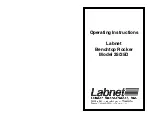
Defining independent and simultaneous movements (item 5)
One of two modes can be selected by clicking the button:
•
Simultaneous Mode
The prosthetic component of the linked signals can be controlled with the other prosthetic components.
•
Sequential Mode
All prosthetic components in “Sequential Mode” can execute a single movement.
Defining the winner method (item 6)
The “Largest Wins” or “First Wins” method can be selected by clicking the button:
•
Largest Wins
The strongest signal that exceeds the ON threshold takes control of the corresponding prosthetic component.
•
First Wins
The first signal that exceeds the ON threshold takes control of the corresponding prosthetic component.
•
Transfer of the setting
With the First Wins/Largest Wins setting, the elbow joint must be switched off and back on to save the
changes.
The rotation settings are always selected first! These settings are automatically applied to the setting of the elbow
joint as well.
7.3.2.13 Shifting the signal sequence
The view of a signal sequence is analysed in real time. The last 60 seconds are always displayed. The view can be
shifted to the left and right.
7.3.2.14 Adjusting switching thresholds
The switching thresholds can be adjusted individually for four-channel control (4-CH), co-contraction and double-
channel control (1-ELE).
1.
4 Channel switching thresholds
Slider for adjusting the switching thresholds for four-channel control.
2.
Co-contraction switching thresholds
Slider for adjusting the switching thresholds for co-contraction
3.
ON threshold
Defined setting for all six control signals.
All switching thresholds are connected directly with the predefined switching channels. The colour of the switching
threshold in the graphical representation (MyoGraph) corresponds to the colours of the predefined switching sig
nals.
65
DynamicArm Plus 12K110N=*
Handling








































